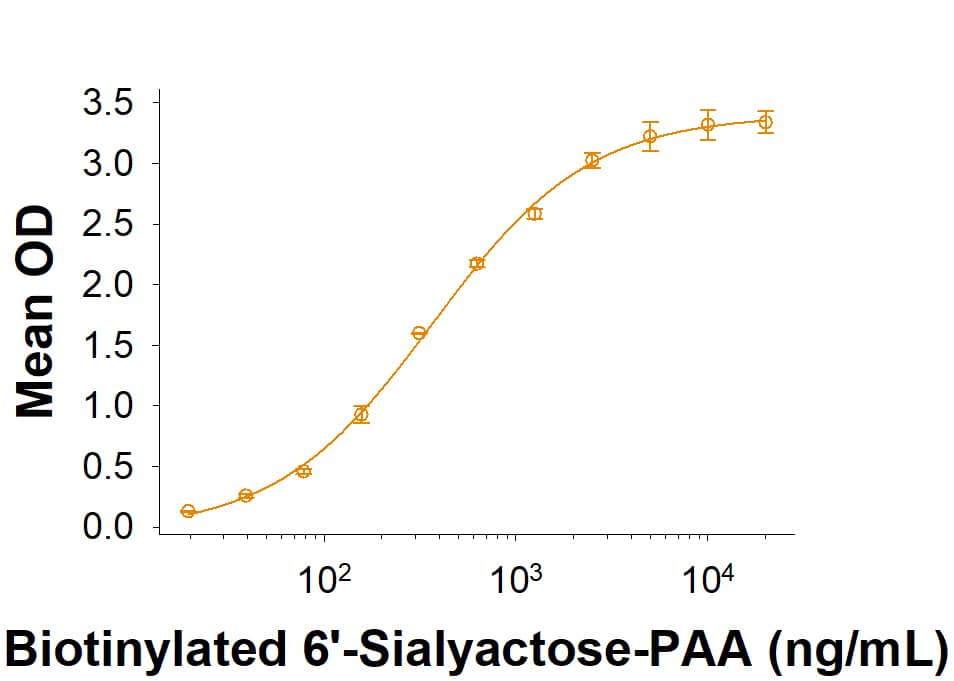Recombinant Mouse Siglec-G Fc Chimera Protein, CF
R&D Systems, part of Bio-Techne | Catalog # 10103-SL

Key Product Details
Source
NS0
Accession #
Structure / Form
Disulfide-linked homodimer
Conjugate
Unconjugated
Applications
Bioactivity
Product Specifications
Source
Mouse myeloma cell line, NS0-derived mouse Siglec-G protein
| Mouse Siglec-G (Met19-Lys543) Accession # Q80ZE3.1 |
IEGRMDP | Mouse IgG2a (Glu98-Lys330) |
| N-terminus | C-terminus |
Purity
>95%, by SDS-PAGE visualized with Silver Staining and quantitative densitometry by Coomassie® Blue Staining.
Endotoxin Level
<0.10 EU per 1 μg of the protein by the LAL method.
N-terminal Sequence Analysis
Met19
Predicted Molecular Mass
86 kDa
SDS-PAGE
102-114 kDa, under reducing conditions
Activity
Measured by its binding ability in a functional ELISA.
Recombinant Mouse Siglec-G Fc Chimera (Catalog # 10103-SL) binds to biotinylated 6'-Sialylactose-PAA.
Scientific Data Images for Recombinant Mouse Siglec-G Fc Chimera Protein, CF
Recombinant Mouse Siglec-G Fc Chimera Protein Binding Activity.
In a functional ELISA. Recombinant Mouse Siglec-G Fc Chimera (Catalog # 10103-SL) binds to biotinylated 6'-Sialylactose-PAA.Recombinant Mouse Siglec-G Fc Chimera Protein SDS-PAGE
2 μg/lane of Recombinant Mouse Siglec-G Fc Chimera (Catalog # 10103-SL) was resolved with SDS-PAGE under reducing (R) and non-reducing (NR) conditions and visualized by Coomassie® Blue staining, showing bands at 102-114 kDa and 205- 230 kDa, respectively.Formulation, Preparation and Storage
10103-SL
| Formulation | Lyophilized from a 0.2 μm filtered solution in PBS with Trehalose. |
| Reconstitution | Reconstitute at 500 μg/mL in PBS. |
| Shipping | The product is shipped at ambient temperature. Upon receipt, store it immediately at the temperature recommended below. |
| Stability & Storage | Use a manual defrost freezer and avoid repeated freeze-thaw cycles.
|
Background: Siglec-G
References
- Crocker, P.R. et al. (2007) Nat. Rev. Immunol. 7:255.
- Poe, J.C. and T.F. Tedder (2012) Trends Immunol. 33:413.
- Meyer, S.J. et al. (2018) Front. Immunol. 9:2820.
- Angata, T. et al. (2001) J. Biol. Chem. 276:45128.
- Chen, G-Y, et al. (2014) Glycobiology 24:800.
- Li, N. et al. (2001) J. Biol. Chem. 276:28106
- Rapoport, E. et al. (2003) Bioorg. Med. Chem. Lett. 13:675.
- Whitney, G. et al. (2001) Eur. J. Biochem. 268:6083.
- Kitzig, F. et al. (2002) Biochem. Biophys. Res. Commun. 296:355.
Long Name
Sialic Acid Binding Ig-like Lectin G
Alternate Names
Siglec-10, SiglecG
Entrez Gene IDs
243958 (Mouse)
Gene Symbol
SIGLECG
UniProt
Additional Siglec-G Products
Product Documents for Recombinant Mouse Siglec-G Fc Chimera Protein, CF
Product Specific Notices for Recombinant Mouse Siglec-G Fc Chimera Protein, CF
For research use only
